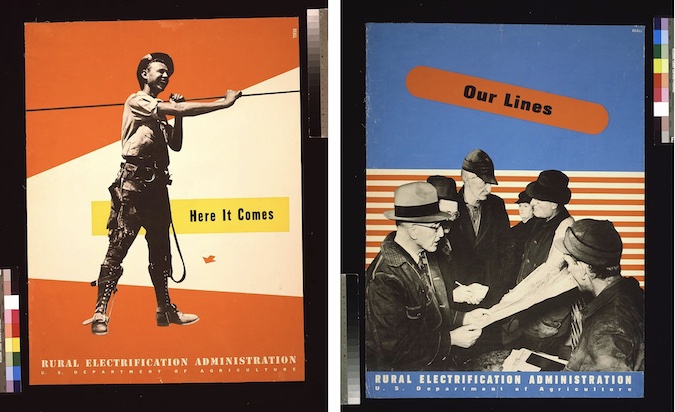Local leaders, residents needed persistence in bringing rural electrification to outlying areas

A series of colorful posters created by graphic artist Lester Beall was used to promote the Rural Electrification Administration. The images featured in this article are from the Library of Congress Prints and Photographs collection, www.loc.gov. The poster at left shows farmers organizing to arrange for power.
‘Electric power proved to be our greatest assistance to modern living. It gave us light, pumped our water supply into our homes enabling us to enjoy a bathroom, it preserved our food from spoiling, heated water and cooked our food.’
By Catherine Cooper, Orleans County Historian
Illuminating Orleans, Vol. 2, No. 34
As previously mentioned, a 160-mile-long electrical power transmission line, which stretched from the Niagara River to Syracuse and traversed through Orleans County, went into service on July 7, 1906.
However, it was quite some time before area farmers had access to electricity, since running wires to far-flung farms was an expensive proposition. By the 1930s only 10% of rural America had electric power. Those who did have power had arranged for it themselves by forming local co-operatives, an involved and costly process.
The Medina Daily Journal of May 10, 1924, noted that:
“The people of Millville are to have electric lights and power. Since they were unable to secure sufficient subscribers on Maple Ridge, they will connect with the electric line which comes within a mile of the village on the east.”
Homer L. Waldo of the Town of Barre remarked in a 1983 Oral History interview that:
“At that time, you had to provide the right of way for the electric company to put their poles down. You had to get signers for the right of way for them. You had to guarantee them $70 a month for every mile they extended the line.”
Some farmers were reluctant to join, Waldo mentioned that they had to convince a reluctant farmer on Pine Hill Road to join.
J. Howard Pratt also recalled the difficulty of getting the required number of signers to co-operate. Acquiring the right of way to pass wires overhead was also an issue. His own family’s access to power was delayed two years on account of recalcitrant neighbors who would not co-operate. His home was finally supplied when the power company set up their poles along another farm to bring the desired current to the Pratt household.

(Left) A farmer uses an electric power sharpener. (Right) A woman is content while sitting her home.
President Franklin D. Roosevelt established the Rural Electrification Administration in 1935. A year later, the Rural Electrification Act made provisions for a lending program to fund the formation and operation of not-for-profit, consumer-owned electric cooperatives. The loans were to be re-paid within 30 years.
In 1935, the Niagara, Lockport and Orleans Power Company announced plans to bring service to over 1,400 rural customers in Orleans County and parts of Niagara and Monroe counties. The minimum monthly charge to customers was to be reduced from $7 to $2.
Power company officials noted that the success and speed of the program would depend on how soon rural customers would wire their homes and equip them with fixtures. To this end, they collaborated with agencies such as the Farm Bureau.
On January 13, 1936, over one hundred people braved icy roads and bitter winds to attend a program about electrifying their farms. The session which was held in Albion, was arranged by the Farm Bureau and the Rural Electrification Committee of Orleans County. Committee members included Harry DeLano of Barre Center, H.G. Butler of Kenyonville, Miles Luttenton of Albion, J. Stanley Pratt of Gaines, Mrs. William Blackburn of County Line and George Snaith of Medina.
C.N. Turner of the Cornell Agriculture Engineering Dept. advised farmers on wiring plans for the home, yard, barn, poultry house and other buildings, the correct type of wire to use, how to figure the load of current and determine the size of wire and fixtures.
Miss Orilla Wright of the Home Economics College advised on home lighting, outlet locations, convenience outlets and direct service wires. Farmers were advised to request service plans from Power Company agents and to stick to those plans regardless of what contractors might suggest.
By the 1950s, over 90% of rural homes had access to electricity. Finally, rural Americans could enjoy the benefits of electric power.
J. Howard Pratt remarked in Memories of Life on the Ridge:
“Electric power proved to be our greatest assistance to modern living. It gave us light, pumped our water supply into our homes enabling us to enjoy a bathroom, it preserved our food from spoiling, heated water and cooked our food.”

























































